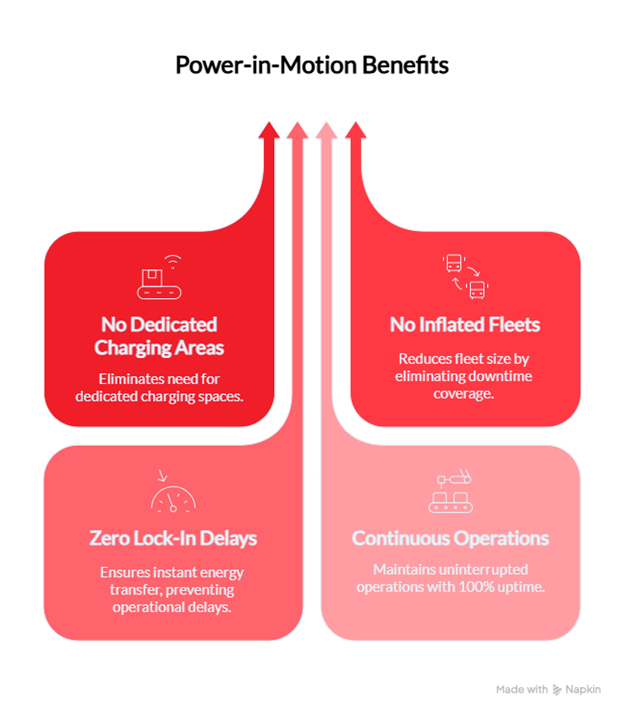If you are an OEM building advanced automation solutions or a goods-to-person operator running high-throughput warehouses, you already know what Automated Guided Vehicles (AGVs) can do. The real question is: how do you make AGVs work harder, scale smarter, and deliver measurable ROI without inflating fleets or drowning in infrastructure costs?
This guide is about helping decision-makers like you evaluate where AGVs fit, what technologies eliminate old bottlenecks, and how to set up a fleet that doesn’t just move materials but drives profitability.

AGVs in Next-Gen Warehouse Design
AGVs have shifted from being point solutions to being part of the core infrastructure of next-generation facilities. For OEMs, that means designing systems where AGVs seamlessly integrate with WMS, WES, and MES platforms. For operators, it means structuring workflows so AGVs are not isolated tools but essential links in continuous, goods-to-person fulfillment.
The facilities getting it right are the ones asking:
- How can AGVs maintain continuous uptime without expanding the fleet?
- How do AGVs impact facility footprint, especially when chargers consume valuable space?
- What’s the total cost of ownership when energy, infrastructure, and scalability are factored in?

The Cost of Downtime in AGV Fleets
Operators know the math: every time an AGV docks for charging, productivity drops. To compensate, fleets are inflated by 20 percent or more. Space is consumed by chargers, routes are interrupted, and ROI is delayed.
A Tier 1 automotive manufacturer faced this exact issue. With a 50-robot fleet, only 30 percent of production time was fully efficient because of charging downtime. After adopting in-motion charging, the company cut automation-related losses by 50 percent, freed floor space, and saved over $2 million annually.
For OEMs, this highlights a design principle: energy strategy cannot be an afterthought. For operators, it’s the difference between barely keeping up and unlocking true throughput.
Eliminating the Charger Bottleneck
The next generation of AGVs is powered differently. Power-in-Motion technology allows AGVs to charge while moving along their operational routes. That means:
- No dedicated charging areas consuming floor space
- No inflated fleets just to cover downtime
- Zero lock-in delays, with energy transfer happening in milliseconds
- Continuous operations with 100 percent uptime
For OEMs, integrating in-motion charging into system design reduces the footprint required and boosts customer ROI. For goods-to-person operators, it means every robot purchased is a working robot, not a backup sitting idle at a dock.

Integration is Where the ROI Lives
AGVs without integration are just expensive movers. The real performance gains come from tight integration with WMS and WES platforms. This allows operators to:
- Synchronize AGV movement with picking, replenishment, and shipping
- Optimize routes dynamically for throughput
- Gather energy and performance data in real time for predictive decision-making
CaPow’s Genesis Energy Management System (GEMS) pushes this even further by providing visibility into fleet energy use, proactive alerts, and integration with warehouse systems. OEMs can design smarter platforms, and operators can manage fleets with a level of control that directly translates into efficiency.
AGVs vs. AMRs: The Hybrid Approach
OEMs and operators are not debating AGVs versus AMRs anymore- they are designing hybrid fleets. AGVs provide predictable, high-volume movement in structured environments. AMRs add agility where flexibility is required.
The facilities gaining an edge are those that:
- Assign AGVs to repetitive, high-throughput “money routes”
- Deploy AMRs for exceptions, dynamic storage, or reconfigurable areas
- Manage both fleets under one energy and control framework
This approach maximizes ROI and prevents overspending on flexibility where consistency would suffice.
Sustainability and AGVs: A Business Imperative
Sustainability isn’t a marketing checkbox anymore; it is shaping customer decisions and compliance requirements. AGVs equipped with in-motion charging and optimized batteries deliver tangible sustainability benefits:
- Smaller, longer-lasting batteries cut lithium usage by up to 40 percent
- Extended battery life reduces replacement cycles by 30 to 40 percent
- Reduced reliance on dedicated chargers lowers energy waste
- Scaled across fleets, emissions can drop by hundreds of megatons annually
For OEMs, sustainability-ready AGVs are a differentiator in RFPs. For operators, they mean lower costs and stronger compliance positioning.
The Strategic Playbook for AGV Success
For decision-makers designing or deploying AGVs, success comes down to five rules:
- Design for uptime, not headcount replacement. Every AGV should be a working AGV.
- Integrate energy strategy from day one. Avoid outdated charging models that inflate costs.
- Think hybrid. Use AGVs for consistency and AMRs for flexibility.
- Measure relentlessly. Track throughput, uptime, and energy to refine operations continuously.
- Future-proof the fleet. Ensure upgrade paths for both hardware and software.
The Bottom Line
Automated Guided Vehicles are not experimental tools or optional add-ons. They are strategic infrastructure in next-generation warehouse automation. For OEMs, the opportunity is to design systems where AGVs are not just reliable, but perpetually available. For goods-to-person operators, the imperative is to demand fleets that never stop moving.
The essential guide is clear: invest in AGVs with uptime built in, integrate energy strategy into the core of your operation, and position your facility for a future where material flow is uninterrupted, scalable, and sustainable.
Anything less, and you risk building yesterday’s warehouse for tomorrow’s competition.



